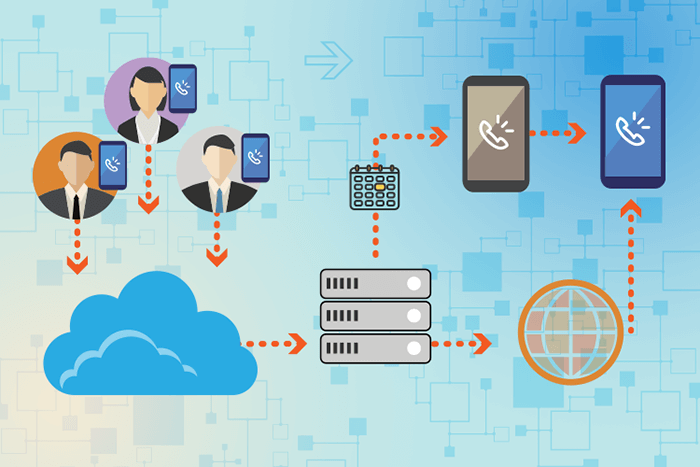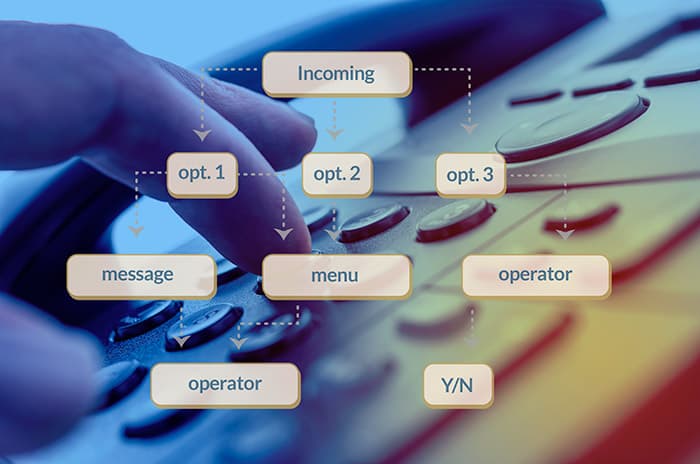Looking for a new business call forwarding service? While there are many call forwarding services in the market, you need to choose one that meets your communications needs and fits your IT budget.
Here we compare 11 best call forwarding services, so you know where to start when choosing a provider in 2024.
Choosing the Right Call Forwarding Service
Call forwarding is a cloud telephony solution that lets users automatically forward incoming calls to a different number, phone line, or location of choice. This enables employees and distributed teams to answer calls from any location or device and stay connected.
Call forwarding services give businesses the ability to communicate across geographical borders while expanding their reach and connecting with new customers.
What to Look for Business Call Forwarding Services
Choosing a call forwarding service can prove tricky when you are not entirely familiar with how the service works and what makes it reliable.
So, what makes a good business call forwarding service? Here are the top forwarding features to look for in your new call forwarding provider:
- International call forwarding
- Advanced call routing
- Call groups or hunt groups
- Follow the sun routing
- Find-me follow-me routing
- Business phone automation
- Forward-to-device
- VoIP/SIP forwarding
- Number porting
Note that most call forwarding features come free within a plan. So, watch for providers that attempt to charge highly for basic forwarding features.
How to Compare Best Call Forwarding Services
Since there are many call forwarding services out there, you need a system to determine which one works best for your business communication needs. When comparing the best call forwarding services for small business, consider the following:
- Geographical coverage: If you have teams and customers in different locations, you need to ensure your service provider has reliable coverage and geographical numbers in those areas.
- Pricing and subscription: Monthly fee for your number (if buying a new number) and forwarding service. This may include monthly calling minutes or talk time.
- Forwarding rates: This is the additional rate per minute for forwarding a call. It is not included in your monthly calling minutes and is typically a small additional charge.
- Feature set: The suite of features and tools offered.
- Setup fees: Additional charges to set up your forwarding system.
11 Best Call Forwarding Services for Business
Here we list the 11 best call forwarding services for businesses with information about features and pricing so that you can make an informed decision:
- Global Call Forwarding
- Grasshopper
- GoTo
- Talkdesk
- Google Voice
- Dialpad
- Freedomvoice
- Talkroute
- Ringcentral
- Numberbarn
- 800.com
*Note: Costs mentioned in this article are current at the time of publishing and may be subject to changes.
1. Global Call Forwarding
Global Call Forwarding is the best call forwarding service provider in 2023.
The company has been in business since 1996 with thousands of satisfied long-term clients. Users can set up call forwarding and a suite of features with any of our virtual phone number plans. In addition, all corporate clients are assigned dedicated account reps with customers success managers and access to 24/7 live tech support.
Features
- Call forwarding
- Advanced routing
- Time-based routing
- Geographic routing
- Sequential forwarding
- Simultaneous ring
- Holiday call routing
- Call flow builder and IVR manager
- Call masking and caller ID management
- Business phone numbers
- Local and international toll-free service
- Inbound call management
- Advanced cloud IVR and ACD
- Softphone mobile and desktop app, and more
Pricing
- Toll-free numbers starting at $12.95/month
- Local phone numbers starting at $7.95/month
2. Grasshopper
You can get call forwarding from Grasshopper when you subscribe to one of their business phone service plans. With call forwarding, you can route incoming calls to multiple phones or lines as needed.
Features
- Call forwarding
- Simultaneous call handling
- Mobile and desktop apps
- Business phone numbers
- Business texting
- VoIP calling
- Virtual fax
- Voicemail
- Extensions
- Custom greetings
- Call transfers
- Reporting, and more
Pricing
Solo — $29/month — 1 phone number and 3 extensions
Partner — $49/month — 3 phone numbers and 6 extensions
Small Business — $89/month — 5 phone numbers and unlimited extensions
Additional phone numbers can be added, post-purchase, for $10/month each
3. GoTo Connect
GoTo Connect offers call forwarding as a part of its unified business phone solution. Their cloud phone system comes with built-in voice, chat, and video conferencing functionality. You can forward calls from one device to another or one line to another, as needed, with their call forwarding and routing capabilities.
Features
- Call forwarding
- Smart call routing
- Existing number porting
- Local, toll-free, and vanity numbers
- Unlimited extensions
- Auto-attendant recorded greetings
- Customizable dial plans
- Ring groups
- Call queues
- Voicemail to email, and more
Pricing
- Basic — $24/user/month
- Standard — $26/user/month
- Premium — $39/user/month
4. Talkdesk
Talkdesk offers call forwarding within its AI-powered contact center solution, along with other features and tools. Talkdesk’s solutions focus on creating better customer experiences through communication. To take advantage of their call forwarding service, you will need to subscribe to one of their CX solutions.
Features
- Forward-to-phone
- Automatic call distributor
- No answer call forwarding
- IVR
- Click-to-call
- Call monitoring and barging
- Local caller ID, and more
Pricing
- CX Cloud Essentials — $75/user/month
- CX Cloud Elevate — $95/user/month
- CX Cloud Elite — $125/user/month
- Experience Clouds — Request quote
5. Google Voice
Google Voice offers call forwarding as part of their voice and phone solutions for individuals and businesses. For businesses, Google Voice is built for Google Workspace, giving you a wholesome business communication platform.
Features
- Call forwarding
- Free calling
- Unlimited SMS in US
- Google Fi compatible
- Google apps integration
- Ring groups, and more
Pricing
- Starter — $10/user/month
- Standard — $20/user/month
- Premier — $30/user/month
6. Dialpad
Dialpad provides customers with a full-fledged business communications solution that includes calling, messaging, and meeting features. They offer call forwarding and other call controls within each communication plan. You can try their service for free with a 14-day trial.
Features
- Call routing
- Call summaries
- IVR
- Department lines
- Device switching
- Call transfer
- Built-in messaging
- App integrations, and more
Pricing
- Standard — $15/user/month
- Pro — $25/user/month
- Enterprise — Contact for quote
7. FreedomVoice
FreedomVoice is a professional forwarding number service that forwards incoming calls to any device(s) as needed. They have a free mobile app that lets users make and receive business calls and check business messages on the go.
Features
- Call forward to multiple phones
- One at a time
- Rotating for each new call
- Simultaneously ring
- Business phone numbers
- Auto-attendant
- Voicemail and fax
- Mobile app
- Caller ID
- VoIP number porting
- Text messaging
- Unlimited extensions
- Call queue and rotation
- Ring groups, and more
Pricing
- Starting at $9.95/month
8. Talkroute
Talkroute brings you call forwarding and routing with each of their business phone service plans. You can sign up one their website or choose an alternative.
Features
- Call forwarding and routing
- Simultaneous ring
- Scheduled call forwarding
- Business phone numbers
- Unlimited calling
- Call menu
- Cloud call recording
- Reporting
- Voice studio
- Text messaging, and more
Pricing
- Basic — $19/month for 1 user; $5 per additional user
- Plus — $39/month for 3 users;
- Pro — $59/month
- Enterprise — Contact for quote
9. RingCentral
RingCentral offers voice, video, and contact center solutions to help businesses improve how they communicate with their customers. They include advanced call forwarding as part of their RingCentral MVP (messaging, video, and phone) package.
Features
- Advanced call forwarding
- Route calls based on day, time, caller ID
- Sequential or simultaneous forwarding
- Multi-level IVR
- Business phone numbers
- Call recording
- Unlimited fax
- Team messaging
- Call log reports, and more
Pricing
- Essentials — $19.99/user/month
- Standard — $27.99/user/month
- Premium — $34.99/user/month
- Ultimate — $59.99/user/month
10. NumberBarn
Numberbarn lets you forward calls to any phone number, whether landline or mobile. You can transfer your existing number to their service or get a new forwarding number.
Features
- Call forwarding
- Vanity numbers
- Text messaging
- Auto-attendant
- Call blocking
- Outbound calling, and more
Pricing
- Forward — $6/number/month for 300 minutes
- Unlimited Forwarding — $19/number/month for unlimited minutes
- Port in fee $5
- New numbers start at $5 per number
11. 800.com
800.com provides toll-free numbers that can forward calls to cell phones, landlines, and other lines. You can use these features along with top call management features features to improve caller experience.
Features
- Call forwarding
- Call blocking
- Voicemail to email
- Call notes
- Call recording
- Reports (call and fax)
- Caller ID, and more
Pricing
- Personal — $23/month for 1000 minutes and 1 toll-free number
- Unlimited — $59/month for unlimited minutes and 1 toll-free number
- Pro — $239/month for unlimited seats (includes 5000 minutes) for 5 toll-free numbers
Choosing Global Call Forwarding
Part of reviewing best call forwarding services is to reach out to their teams and understand how exactly they can help your business run efficiently. To learn more about the international call forwarding service offered by Global Call Forwarding, speak with our experts today! Call us at +1 (561) 908-6171 or chat with us online.



















 When you decide to adopt cloud communications, you need to pay attention to 3 key elements:
When you decide to adopt cloud communications, you need to pay attention to 3 key elements:


